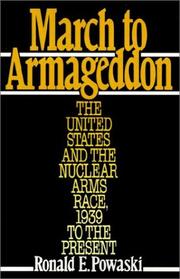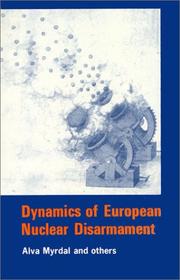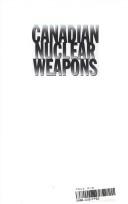| Listing 1 - 10 of 353 | << page >> |
Sort by
|
Book
ISBN: 9212420532 9789212420530 Year: 1985 Volume: 13 Publisher: New York (N.Y.): Nations Unies,
Abstract | Keywords | Export | Availability | Bookmark
 Loading...
Loading...Choose an application
- Reference Manager
- EndNote
- RefWorks (Direct export to RefWorks)
Armes nucleaires et desarmement --- Atomic weapons and disarmament --- Kernwapens en ontwapening --- Désherbage --- Deselectie
Book
ISBN: 0900492902 Year: 1976 Volume: 120 5 Publisher: London International institute for strategic studies
Abstract | Keywords | Export | Availability | Bookmark
 Loading...
Loading...Choose an application
- Reference Manager
- EndNote
- RefWorks (Direct export to RefWorks)
Nuclear disarmament --- Atomic bomb and disarmament --- Atomic weapons and disarmament --- Disarmament, Nuclear --- Nuclear weapons disarmament --- Disarmament --- Antinuclear movement --- Nuclear weapons

ISBN: 0195038789 0195044118 Year: 1987 Publisher: New York Oxford Oxford University Press
Abstract | Keywords | Export | Availability | Bookmark
 Loading...
Loading...Choose an application
- Reference Manager
- EndNote
- RefWorks (Direct export to RefWorks)
Armes nucléaires --- Atomic weapons --- Atoomwapens --- Kernwapens --- Nuclear weapons --- Arms race --- Course aux armements --- History --- Histoire --- United States --- Etats-Unis --- Defenses --- Défense --- Armes nucléaires --- Défense --- 20th century
Book
ISBN: 0571119751 Year: 1982 Publisher: London Faber and Faber
Abstract | Keywords | Export | Availability | Bookmark
 Loading...
Loading...Choose an application
- Reference Manager
- EndNote
- RefWorks (Direct export to RefWorks)

ISBN: 0851243215 Year: 1981 Publisher: Nottingham Spokesman
Abstract | Keywords | Export | Availability | Bookmark
 Loading...
Loading...Choose an application
- Reference Manager
- EndNote
- RefWorks (Direct export to RefWorks)
A series of interesting contributions on the modernisation of INF by the USA and USSR in Europe.
Book
ISBN: 9211422302 Year: 1999 Publisher: New York, N.Y.
Abstract | Keywords | Export | Availability | Bookmark
 Loading...
Loading...Choose an application
- Reference Manager
- EndNote
- RefWorks (Direct export to RefWorks)
Nuclear disarmament --- Atomic bomb and disarmament --- Atomic weapons and disarmament --- Disarmament, Nuclear --- Nuclear weapons disarmament --- Disarmament --- Antinuclear movement --- Nuclear weapons --- South Africa --- Africa, South --- Military policy. --- Polemology
Book
ISBN: 1280491477 9786613586704 0820343803 9780820343808 9780820336893 0820336890 9780820342467 0820342467 Year: 2012 Publisher: Athens : University of Georgia Press,
Abstract | Keywords | Export | Availability | Bookmark
 Loading...
Loading...Choose an application
- Reference Manager
- EndNote
- RefWorks (Direct export to RefWorks)
In recent decades the debate on nuclear weapons has focused overwhelmingly on proliferation and nonproliferation dynamics. In a series of Wall Street Journal articles, however, George Shultz, William Perry, Henry Kissinger, and Sam Nunn called on governments to rid the world of nuclear weapons, helping to put disarmament back into international security discussions. More recently, U.S. president Barack Obama, prominent U.S. congressional members of both political parties, and a number of influential foreign leaders have espoused the idea of a world free of nuclear weapons.Turning this vision into reality requires an understanding of the forces driving disarmament forward and those holding it back. Slaying the Nuclear Dragon provides in-depth, objective analysis of current nuclear disarmament dynamics. Examining the political, state-level factors that drive and stall progress, contributors highlight the challenges and opportunities faced by proponents of disarmament. These essays show that although conditions are favorable for significant reductions, numerous hurdles still exist. Contributors look at three categories of states: those that generate momentum for disarmament; those with policies that are problematic for disarmament; and those that actively hinder progress-whether openly, secretly, deliberately, or inadvertently.Nuclear deterrence was long credited with preventing war between the two major Cold War powers, but with the spread of nuclear technology, threats have shifted to other state powers and to nonstate groups. Slaying the Nuclear Dragon addresses an urgent need to examine nuclear disarmament in a realistic, nonideological manner.
Nuclear disarmament --- Atomic bomb and disarmament --- Atomic weapons and disarmament --- Disarmament, Nuclear --- Nuclear weapons disarmament --- Disarmament --- Antinuclear movement --- Nuclear weapons --- History --- International relations --- Polemology

ISBN: 1554881218 9786611969691 1281969699 9781554881215 1550022997 9781550022995 9781281969699 Year: 1998 Publisher: Toronto, Ontario ; Oxford, England : Dundurn,
Abstract | Keywords | Export | Availability | Bookmark
 Loading...
Loading...Choose an application
- Reference Manager
- EndNote
- RefWorks (Direct export to RefWorks)
Nuclear weapons --- Atomic weapons --- Fusion weapons --- Thermonuclear weapons --- Weapons of mass destruction --- No first use (Nuclear strategy) --- Nuclear arms control --- Nuclear disarmament --- Nuclear warfare --- History.
Book
ISBN: 1536165816 9781536165814 9781536165807 1536165808 Year: 2019 Publisher: New York : Nova Science Publishers,
Abstract | Keywords | Export | Availability | Bookmark
 Loading...
Loading...Choose an application
- Reference Manager
- EndNote
- RefWorks (Direct export to RefWorks)
Nuclear disarmament --- Atomic bomb and disarmament --- Atomic weapons and disarmament --- Disarmament, Nuclear --- Nuclear weapons disarmament --- Disarmament --- Antinuclear movement --- Nuclear weapons --- Korea (South) --- Korea (North) --- Foreign relations
Book
ISBN: 1009039865 1009041150 1009041355 1316510859 9781009041157 9781009041355 9781009039864 Year: 2021 Publisher: Cambridge : Cambridge University Press,
Abstract | Keywords | Export | Availability | Bookmark
 Loading...
Loading...Choose an application
- Reference Manager
- EndNote
- RefWorks (Direct export to RefWorks)
A new nuclear arms race is underway between Russia and the United States, one that focuses on the technology of delivery of nuclear warheads. This book describes how and why this race is happening, who still possesses nuclear weapons, and what constraints apply to those weapons under international law. A global nuclear ban treaty entered into force in January 2021, but the nuclear powers kept distant. The last remaining treaty restraining the arsenals of the two nuclear superpowers will expire in less than five years' time and the risk is that other States will turn to nuclear arms for their defence, further fracturing the non-proliferation regime installed after the Cuban missile crisis.
| Listing 1 - 10 of 353 | << page >> |
Sort by
|

 Search
Search Feedback
Feedback About UniCat
About UniCat  Help
Help News
News